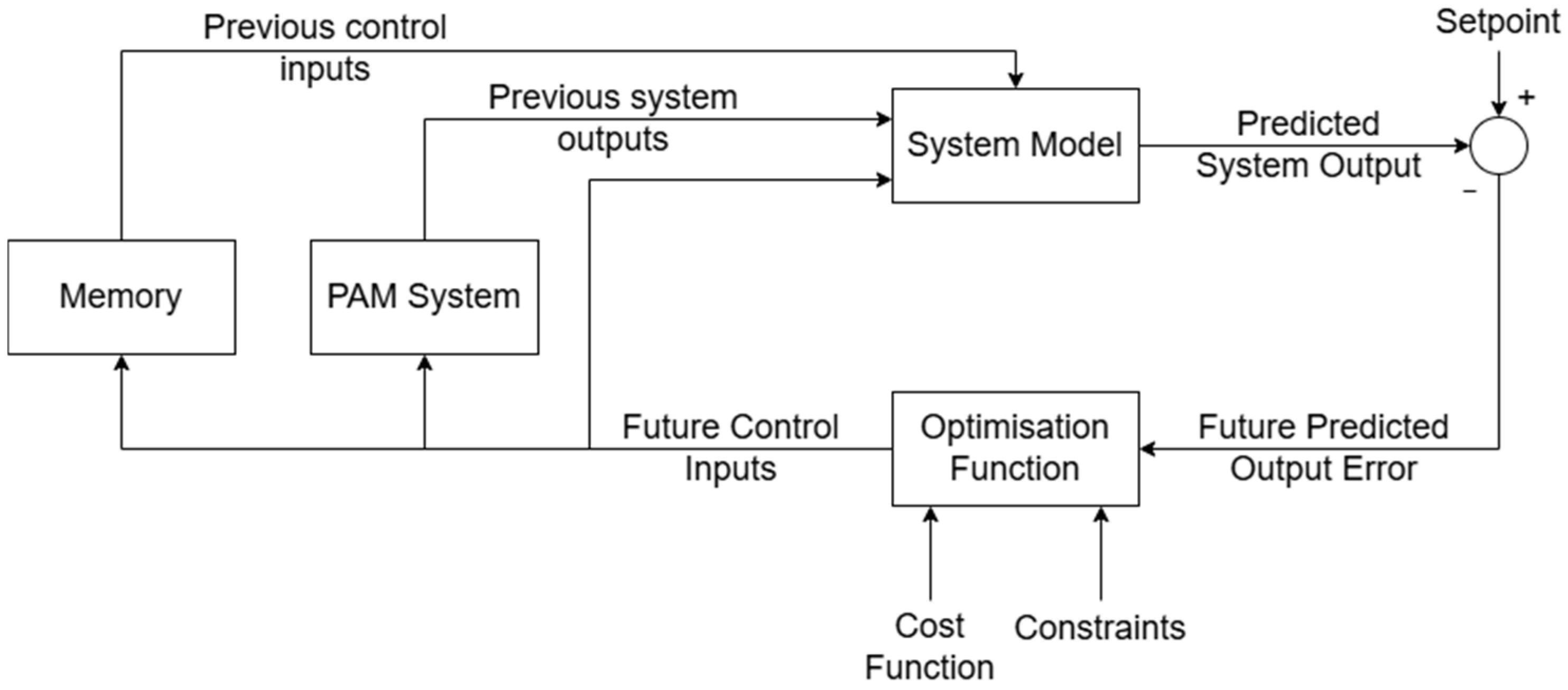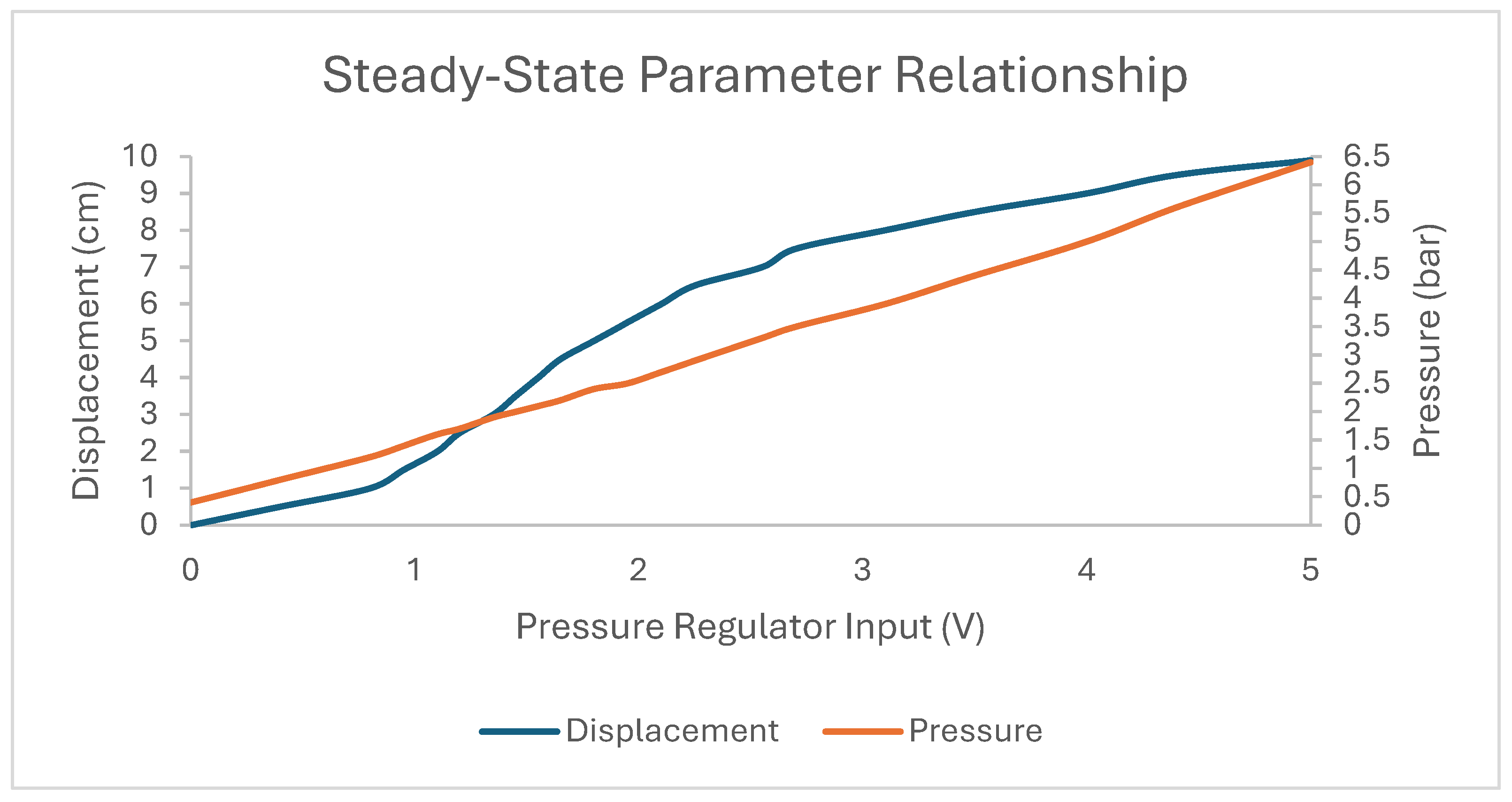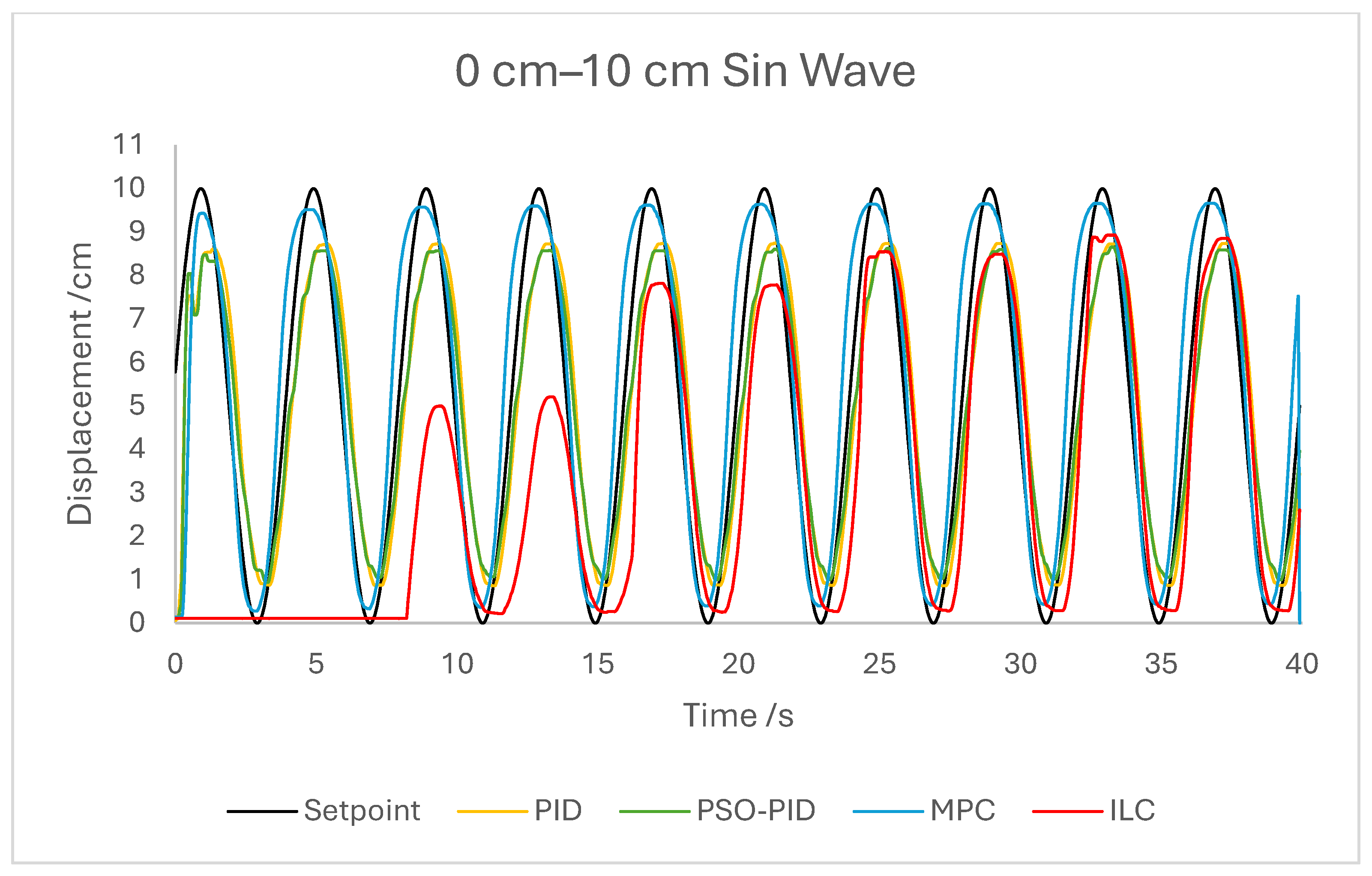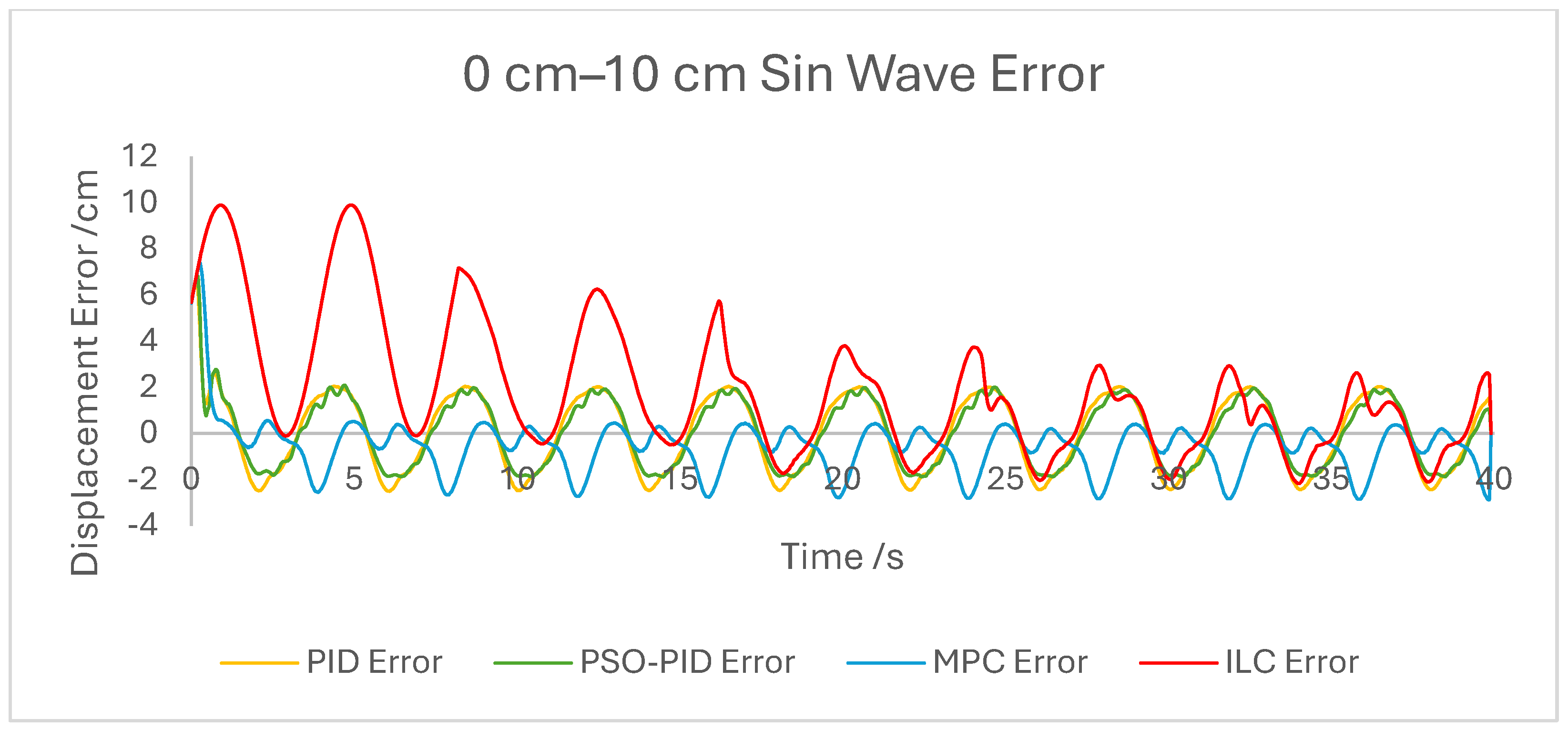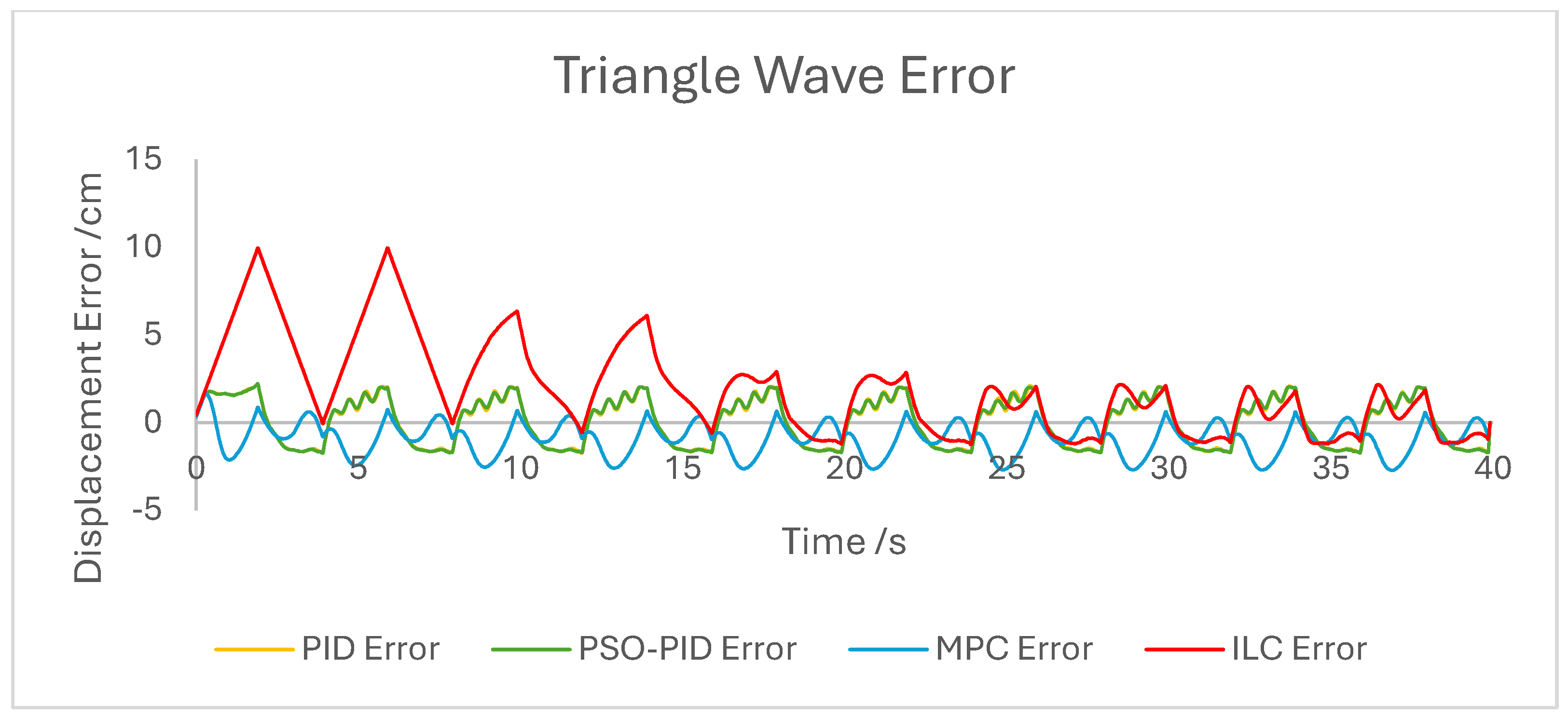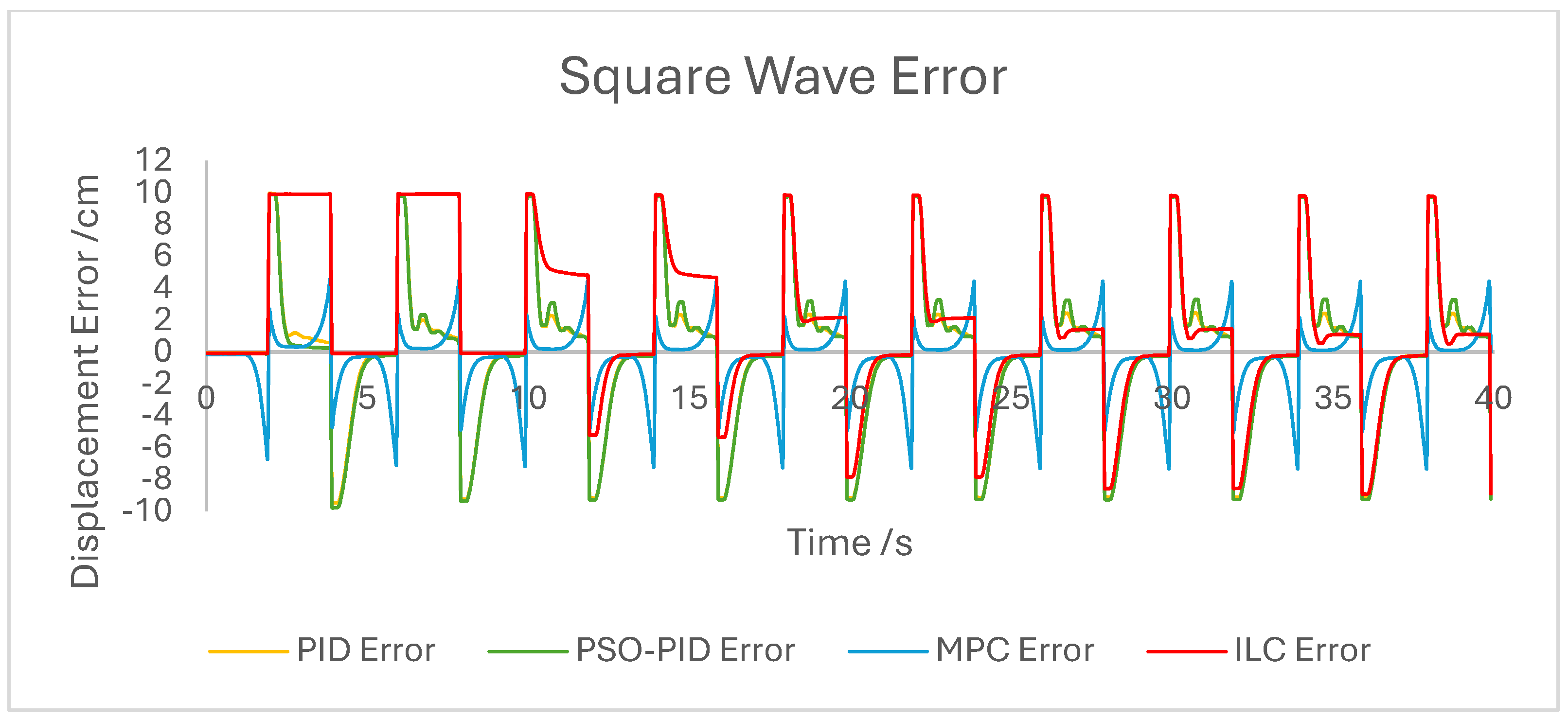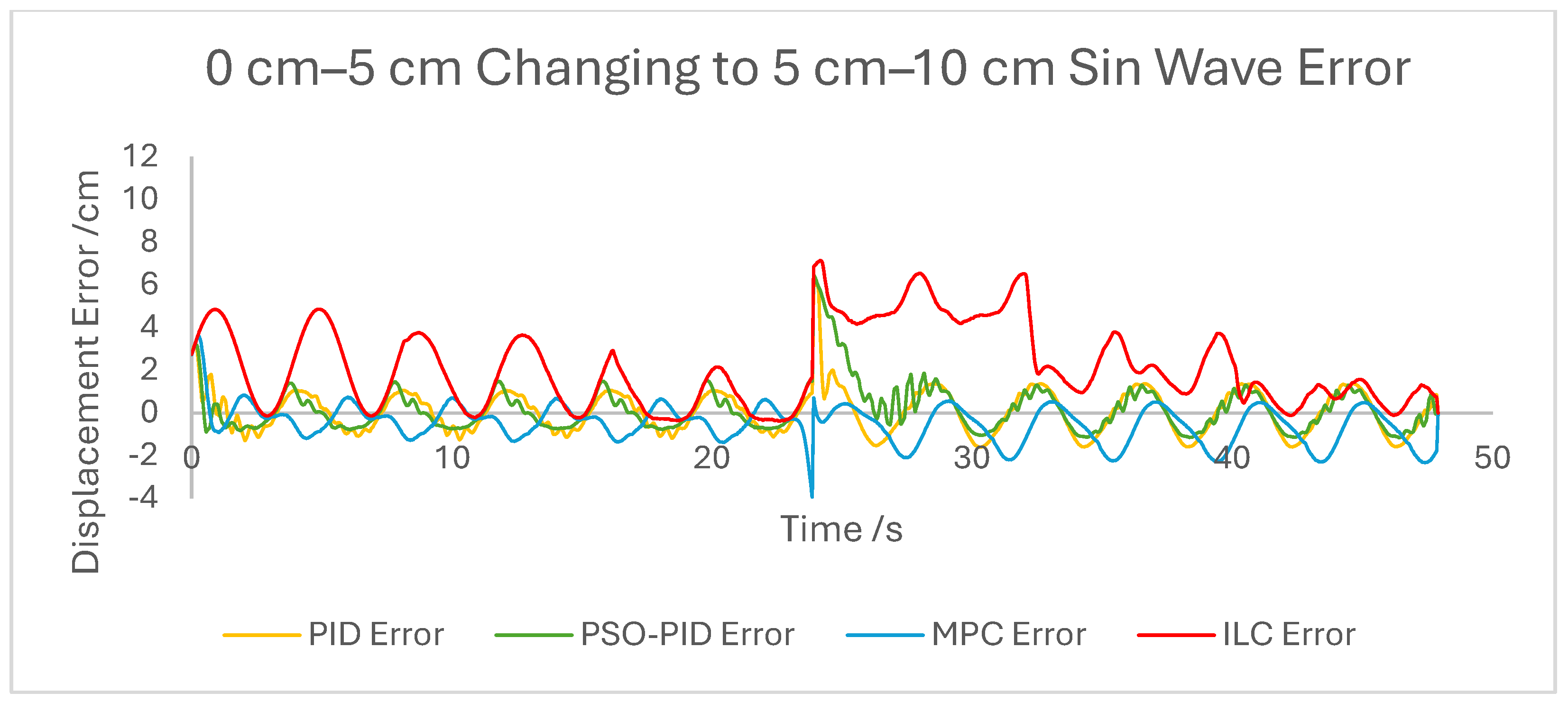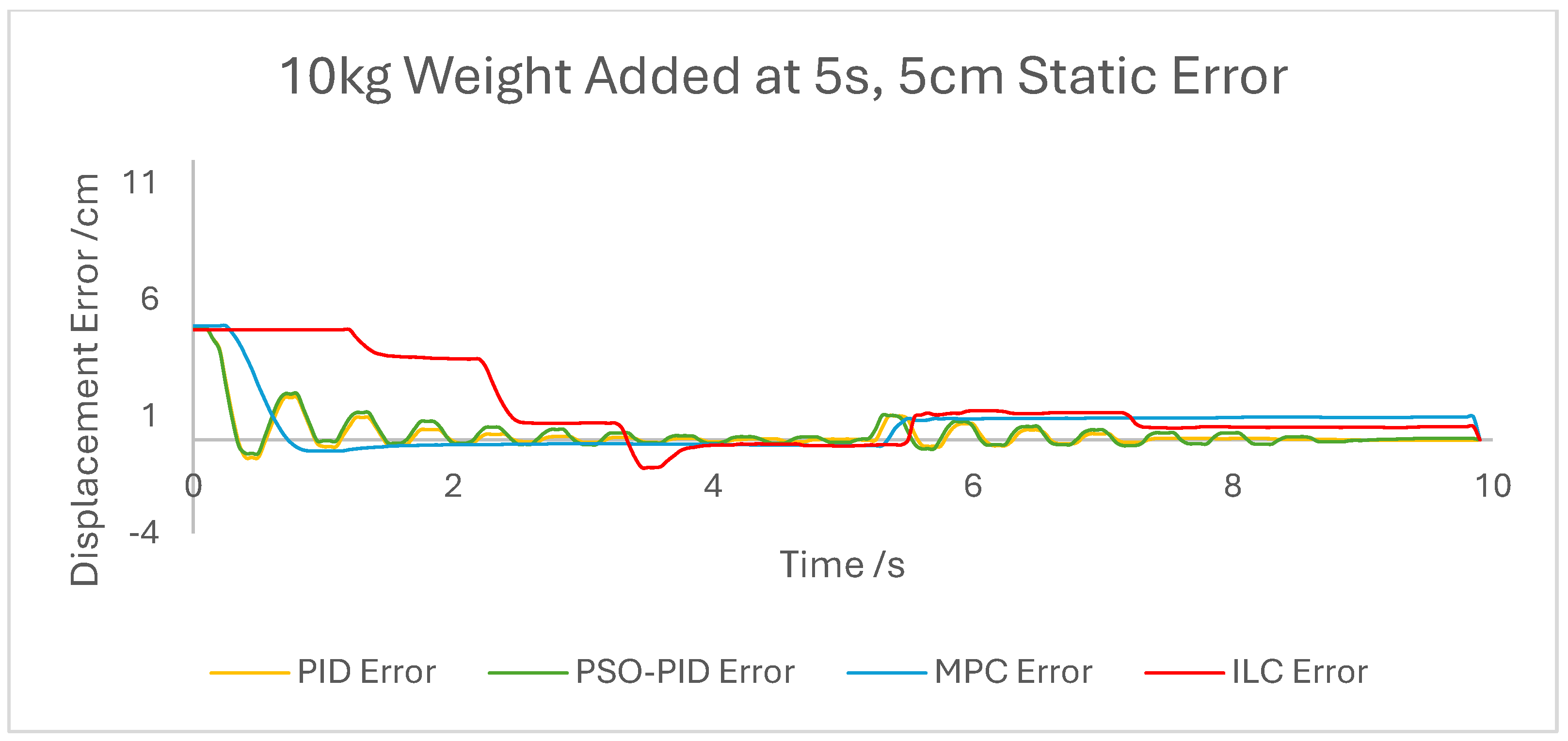1. Introduction
Physical therapy for the restoration of motion in physically and neurologically injured limbs is an incredibly important procedure for the millions of people suffering limited motion worldwide, but with the increasingly limited healthcare services available this puts incredible strain on therapists and healthcare workers. According to the World Stroke Organization, between the years 1990 and 2019 there were more than 12.2 million new stroke cases each year, and by 2019 over 101 million people lived post-stroke [
1]. With 20–25% of stroke survivors never being able to walk without assistance, and 65% unable to use their affected hands normally [
2], this issue is widespread and affects a great number of people every year. In an attempt to reduce the strain on healthcare services and provide the needed care to patients, rehabilitation robotics is an open research field aiming to develop and produce robots capable of giving patients similar treatment to trained therapists. However, the limited functionality of these robots and their high cost have reduced their availability, and the field is still in its infancy. To advance the field, this paper presents research into the actuators used in rehabilitation robots and potential control systems which may improve their functionality.
The type of actuator used in a rehabilitation robot is important for several reasons. They must be capable of repeated, accurate motion to provide the treatment necessary for patients requiring rehabilitation and be able to apply sufficient torque to the patient to move their limb along the required motion, or to resist their motion in the case of active resist exercises but be controllable such that the torque output does not exceed safe values. Specifics of actuator design and control for rehabilitation robotics are detailed in [
3]. Another desirable factor is intrinsic compliance, which can help increase safety and comfort, allow users a degree of freedom of motion, as well as increase the transparency of the system by reducing patient–machine interaction forces. Several compliant actuators exist which are popular in the field of rehabilitation robotics, including Series Elastic Actuators (SEAs) and Pneumatic Artificial Muscles (PAMs), but controlling these actuators comes with its own problems. Due to the nonlinear nature of intrinsically compliant actuators, they act dynamically to input rather than linearly. This makes more traditional controllers like PID less effective in providing accurate motion. Reviews of soft and compliant actuators in rehabilitation robotics are presented in [
4,
5].
The use of pneumatic actuators in lower-limb rehabilitation robots has grown over the past few years, as explored in the review presented in [
6]. Various pneumatic actuators are popular in the field for their compliant dynamics and interactive nature, including McKibben artificial muscles, rubbertuators, air muscles, pneumatic artificial muscles, and pneumatic muscle actuators. It is also mentioned in this review that while PID controllers are suitable for controlling pneumatic actuators, the nonlinear dynamics and complexity of the actuators may not be accurately controlled without further integrated control paradigms. Among those mentioned are various adaptive controllers using PID, a neuro-fuzzy network controller, neural-network based control and sliding mode control. One final suggestion states that a more complicated controller may not be the best approach to this problem, as additional sensors and impedances would increase the overall complexity of the system and make it more difficult to use, and a simpler controller is preferred.
This sort of compliant actuator is used for various purposes in the field, and in different configurations. The robot presented in [
7] uses an antagonistic pair of pneumatic muscles to control a finger rehabilitation robot. This system also uses a magnetorheological dampener, and in experiments both open- and closed-loop PID control systems are implemented. A powered ankle–foot orthosis (PAFO) using a pair of PAMs to provide two degrees of freedom is presented in [
8]. This system uses a sliding-mode controller for actuator control. The system presented in [
9] consists of three separate pneumatic subsystems for body weight support, postural support, and gait orthosis. This system is a full-body gait rehabilitation system and uses an Interval Type-2 Fuzzy Sliding Pulse-Width Modulation Control to allow for proper control of the nonlinear pneumatic systems. A control system is developed in [
10] which incorporates the RBF neural network and sliding mode control to ensure adaptive and disturbance-resistant control of a single-degree-of-freedom rehabilitation robot using a pair of antagonistic PAMs. The robot is designed to function for multiple different limbs. A neural network-based controller is also used in [
11] for a hand rehabilitation robot utilising flexible pneumatic muscles. The intelligent controller has adaptive elements allowing it to accurately control the position of the orthosis despite interference forces and the nonlinearity of the actuators. Another control scheme designed to accurately control pneumatics is presented in [
12] with a multiple-input single-output model free-adaptive control scheme. This controller is applied to a single DOF multi-joint rehabilitation robot which uses two PAMs similar to [
8]. Experiments presented in [
13] aim to determine the dynamic characteristics of PAMs with the intention of accurate servo control. Nonlinear pressure flow values are compensated for using a lookup table, and position control is achieved using a model-based PID controller. This simple control structure achieved good closed-loop regulation and position tracking.
As shown in the literature, there is sufficient interest in pneumatic actuators in the field of rehabilitation robotics to make it an area of growing research, particularly the problem of accurate control. Accurate, reliable, and flexible motion tracking in a rehabilitation robot is essential for its effective use in a real rehabilitation setting. As professional therapists set the desired exercise motions, it is important to have them be properly followed to ensure proper rehabilitation outcomes for patients, as well as ensure their safety in using a robot. A control system able to perform well under many different input requirements also makes the robot more flexible in the conditions and stages of recovery it can treat. However, while good control performance is shown in many studies, there is a lack in comparison data between different intelligent control approaches in PAM-actuated rehabilitation robotics.
To address this limitation and investigate a novel application of prediction and optimisation algorithms, this paper presents preliminary implementation and testing of a Model Predictive Control (MPC) scheme utilising a Particle Swarm Optimisation-based (PSO) modelling method to generate dynamic models of the actuator, tested experimentally on a single-PAM setup in a simple hanging position as a feasibility study for eventual application of the controller to a PAM-driven rehabilitation robot. The development and experimental validation of the PSO-based modelling method is presented in [
14]. This approach involves a phenomenological approximation of the PAM to a mass-spring-damper system, optimising the three parameters using a PSO algorithm in a three-dimensional search space. Based on preliminary testing, the linear model generation method, in which a single model is used to approximate the PAM’s motion over a specific pressure input range, will be used here. The switching issue present in the piecewise and inflate–deflate modes has a magnified effect when used in conjunction with a control algorithm; as such, the linear method was considered the best approach for motion accuracy.
In order that this controller is properly validated in comparison with other controllers commonplace in the field, two other intelligent control strategies were applied to the system, as well as one classical control strategy: iterative learning control (ILC), Particle Swarm Optimised Proportional Integral Derivative Control (PSO-PID), and classical PID control. While PID control is generally regarded as unsuitable for use with nonlinear systems based on its linear nature and poor approximation of time-variant systems, its use is prevalent in control theory as a computationally and mathematically efficient algorithm. As such it will be included in this study as a comparison point to demonstrate the improved effectiveness of intelligent control on the PAM system.
MPC uses a dynamic model of the system to predict over a finite period the behaviour of the system and calculates the control output required to best optimise some cost function over that period. Using this predictive method, the time-variant characteristics of the system are accounted for, and nonlinearities can be included in the model of the system. This makes MPC a suitable controller for PAMs. However, the need for a model of the system makes it difficult to apply to complex systems and actuators. This is especially true for systems including uncertainties and multiple nonlinear factors such as PAMs, as models for such systems tend to include multiple assumptions and simplifications, giving model-based controllers an inherent trade-off between accuracy and computational efficiency. In [
15], a switching model predictive controller is developed for a PAM for the purpose of testing a novel modelling method using PieceWise Affine model approximation. The PAM is initially estimated as a spring-damper system with a second-order differential equation of motion, but in the piecewise modelling estimation the second-order element is ignored. A single PAM is set up vertically to measure displacement with no load attached. The controller, in comparison with the PID control of the same system, is found to have lower motion error values and faster convergence. A 2 DoF robot actuated by two antagonistic pairs of PAMs as presented in [
16] which uses MPC for motion control. Simulations show that the controller provides accurate motion control with small errors and stable steady-state behaviour, with the model used for the system dynamics being a nonlinear eighth-order set of differential equations, with polynomial functions serving as the characteristics of the PAMs. A discrete-valued model-predictive controller dubbed DVMPC is presented in [
17], and improved upon in [
18], for motion control of a novel hybrid-pneumatic electric actuator and a double-acting pneumatic cylinder, respectively. Results from both studies show that novel controllers outperform the state-of-the-art sliding mode control by a significant margin. A lower limb orthosis powered by PAMs and controlled by a neural network-based nonlinear MPC is presented in [
19]. In online experiments, the system meets requirements for each different participant, and the major concerns for inhibited system performance are the PAM’s intrinsically slow rate of motion owing to the maximum allowed air flow into and out of it, and human–machine interaction sensing. MPC has been proven suitable for accurate motion control of PAMs; however, the modelling required for this control method produces another level of complexity, as this in itself is a separate area of study.
ILC is popular for use with nonlinear actuators as it does not rely on a complex model of the system, rather measuring the desired and actual outputs and iteratively calculating the best control signal based on the difference. This makes it suitable for time-varying systems, and there are many examples of its use in rehabilitation robotics using PAMs. The system RUPERT presented in [
20] uses ILC for assistive reach-to-grasp tasks actuated by a series of PAMs, where its use is attributed to the need for a suitable controller for a nonlinear and time-varying system, as well as the repetitive nature of attempting the same task multiple times. Another rehabilitation/assistive robot utilising PAMs is presented in [
21], in which uses an improved PID controller has issue with phase lag relieved using ILC to iteratively adjust control parameters, fixing this lag issue and reducing output error. A simulation of a PAM presented in [
22], utilising ILC to account for the nonlinear and time-varying nature of the actuator, shows results proving the algorithm is capable of accounting for these characteristics, as well as uncertainties in the system. Based on the widespread use and research into ILC in the field of rehabilitation robotics and specifically its usefulness in controlling PAMs, it was chosen as a comparison for the developed MPC in this study.
Similarly to learning algorithms, optimisation is often used to improve the performance of controllers for complex systems, with PSO being a popular optimisation algorithm. PID is often the target of such optimisation as its functionality is heavily tied to how well the small number of parameters are tuned to the system it is to control. An upper limb exoskeleton robot using this method of optimised control is presented in [
23] alongside a method using an improved version of classical PSO, Artificial Bee Colony Optimisation. A lower limb rehabilitation robot presented in [
24] also uses improved PSO-PID control. Both these studies found their optimised controllers to be robust and have more accurate motion control. The study presented in [
25] develops a dynamic neural network and PID controller for control of PAMs, the parameters of which are optimised using the PSO algorithm with Integral Time Absolute Error as the objective function. Another study using a similar technique is presented in [
26] with adaptive and classical synergetic controllers developed for a robotic arm actuated by a PAM.
The experiments presented in this paper aim to test and compare the developed MPC with classical ILC, PID, and PSO-PID in controlling the actuation of a single PAM in online control experiments, for future implementation to a complete PAM-drive rehabilitation robot. The main results for determining effectiveness will be motion tracking accuracy, response to disturbance, and smoothness of motion, as these are necessary for the controller to function well as part of a rehabilitation robot utilising PAMs for actuation. The experiments will take place on a single PAM set up to accurately measure displacement. Weights will be used to apply resistive force to the actuator, as well as to simulate disturbances to the system. Each controller will be implemented and tested with the same test scheme, and the displacement error values will be measured and analysed to determine how well they perform comparatively.
The contributions of this study include development and implementation of a model predictive controller for accurate PAM motion using the PSO-based modelling method presented in [
14] to generate dynamic models of the system, experimental data for comparison of the performance of the MPC as well as other popular controllers in the field of rehabilitation robotics—ILC, PID, and PSO-PID—using an experiment plan designed to simulate the motion and load requirements of PAMs in a rehabilitation robot, as well as a comparative discussion comparing the relative strengths and weaknesses of each controller. Based on the limited examples of comparative studies, this experiment including multiple commonplace controllers will help in quantifiably demonstrating the relative benefits and shortcomings of these controllers and help fill this gap in the literature. The overall aim of this research is to determine the feasibility of the developed MPC, as well as classical ILC and optimised PID controller, for accurate motion control of PAMs in a rehabilitation robot setting, with the future aim to implement the developed algorithms in a PAM-driven rehabilitation robot.
4. Discussion
The dynamic properties of the PAM heavily impact the accuracy of motion under all control schemes at a high-velocity input, such as during the rapid sin wave experiments, in which a 1 Hz setpoint waveform is used rather than the 0.25 Hz used in the other experiments, as well as the square wave experiments. Rather than a fault in the controllers, this is mostly a reflection of the maximum change in displacement the actuator is capable of achieving. This also has an effect under a triangle wave setpoint, as constant velocity is difficult to achieve with dynamic input/output behaviour. The higher frequency experiment, while not an accurate representation of actuator requirements in a rehabilitation setting, was performed to test the higher limits of speed response for the PAM and controllers. The error values for these experiments were generally the highest; however, the comparison between the controller is useful as will be discussed.
The performance of the PID and PSO-PID controllers were generally consistent with each other. Both exhibited oscillating behaviour during most motions, including during constant displacement experiments and during the stationary points of the square wave setpoints. This was exacerbated with the addition of external loads, especially noticeable in the static experiments where the oscillation was mostly present before the weights were removed and after they were added. Both PID control schemes had a poor response time under square wave setpoints compared to the other controllers, with noticeably larger errors at the changing points in the waveform as well as slower settling time; however, the steady-state error at the static points was generally small. The poor response time can also be seen in the sin wave experiments with the PAM motion lagging behind the setpoint. The PSO-PID controller showed lower error values in all experiments than classical PID, and the oscillating behaviour was less pronounced, except during the upper stroke length of the PAM and during the triangle wave setpoint. This behaviour is likely due to a closer fitting to the setpoint at points where the nonlinear nature of the PAM is most pronounced, causing the controller to quickly switch between increasing and decreasing pressure input in an attempt to meet the desired displacement.
The behaviour of the ILC was as expected in all experiments in terms of learning, with convergence to a steady state reached after eight wavelengths, or four iterations of the learning algorithm. Once a steady state is reached the error is typically similar in magnitude to that of the PSO-PID controller, but with no evidence of oscillation about the setpoint. Motion under the ILC is generally smoother than under PID control. ILC suffers from similar response-time issues to PID control, with the PAM motion lagging behind the setpoint even after a steady state is reached. The response time during square wave motion is slightly better than that of PID, with lower settling time and notably no oscillation at the static points, but instantaneous errors are similar in magnitude at the changing points of the waveform. Under external load the ILC performs well, with little impact on the learning rate or the overall motion accuracy. Addition and removal of weights during motion and during static displacement is accounted for by the learning algorithm; however, with a constant setpoint the steady state error under ILC is the worst of the controllers tested here. Under changing setpoints the ILC can respond to the change in a similar time to the initial learning period, but this does result in worse overall error. The learning algorithm does not respond properly to changes in the frequency of the setpoint during motion, with the initial frequency maintained throughout without changing to match the setpoint. This is due to the learning period being based on the wavelength of the setpoint. A more sophisticated learning algorithm could improve on this with a better-defined learning period.
Overall, based on average error values across the experiments’ runtimes as well as maximum error magnitudes, the motion of the PAM under MPC is the most accurate. The response time issue present in the other controllers tested here is removed by the predictive algorithm, although in some cases the actual motion precedes the setpoint, which is a unique issue. With square wave input this is most noticeable, as the PAM motion under MPC changes direction before the changing points of the waveform, resulting in overall lower error values. Under most setpoints the error is lowest under MPC with smoother motion than PID and, as to be expected, a faster settling time than ILC. One major downside of this implementation of MPC is that the model used does not consider external loads to the system, and as such the controller does not change input based on additional loads to the PAM, resulting in larger error values when weights are added. Under rapid motion the predictive algorithm works somewhat against the PAM motion. The system itself is incapable of changing velocity at the rate required by the setpoint, usually resulting in a lagging motion which attempts to reach the peak of the sin wave input. The MPC predicts rapid changes in the setpoint before they occur and changes the direction of motion in advance. While this does result in overall lower error values under MPC than other controllers, the maximum displacement of the PAM is much smaller in practice due to this interaction, which is usually undesirable when displacement accuracy is the priority. The predictive algorithm is capable of adjusting to changes in setpoint waveforms seamlessly. PAM motion immediately before the change in waveform is adjusted to best fit the requirements after the change, so error values are only minorly affected, there is little or no increase in error between the different setpoints, and motion after the change is just as accurate as before.
While the predictive and learning control systems used in this study show promise in accurate motion control for a single actuator, alternative control methodology is required in many rehabilitation robotics applications. Impedance control, such as that presented in [
27,
28], uses force sensor measurements to determine actuator motion. This feedback system is required in active rehabilitation, in which a user applies force to the robot and the motion is assisted or resisted by the system. This would be impractical for the controllers used here to achieve in their current configuration, so they are not sufficient for every control need of a rehabilitation robot.
5. Conclusions
This study presents an intelligent control scheme designed to overcome the nonlinearity of PAMs, Model Predictive Control using PSO-based dynamic modelling, which was implemented on a single PAM setup to test for validity. Three other controllers which are popular in the field of rehabilitation robotics, ILC, PID, and PSO-PID, were also investigated for quantifiable comparison of their performance.
An experiment scheme was designed to test the behaviour of each control scheme under conditions, as would be required in a rehabilitation setting. Displacement of the PAM was measured for each different experiment setpoint and external loading under each of the four control schemes, and the displacement error calculated and compared. Based on these comparisons, it was found that the PID controller performed worst in terms of error magnitude and response time, with undesirable oscillating behaviour in many cases, which was worsened by the addition of weights. Optimised parameters using PSO slightly improved the error values and response times but did not remove the oscillations. The ILC reached a steady state after learning for four iterations in each experiment, with smoother motion and smaller error values than PID. Performance was also not inhibited by external loading, and changes to the setpoint and external loading during motion were accounted for in the next learning iteration. Response time was still slow, however, and the algorithm was incapable of adjusting to changes in frequency. The MPC had the best performance, with smooth motion during all experiments and the overall lowest error values. The prediction algorithm allowed motion in advance of changing setpoints and maintained low error values after changes as well. Due to the method of model generation for the MPC and the lack of feedback, the algorithm was unable to adjust for external loads, and error values were negatively affected by weights.
The results gained in this study prove conclusively that machine intelligence can greatly improve the performance of control systems for PAMs in terms of tracking accuracy, response time, and motion smoothness. Both learning and predictive control methods show excellent performance in most scenarios. Despite being a standard implementation of learning control, the ILC algorithm used in this study showed rapid convergence to accurate motion as well as the ability to sufficiently reject external load and disturbance. The use of additional learning parameters and robust elements could further improve its performance. The predictive nature of MPC especially shows promise as it mitigates many issues which arise in controlling complex actuators like PAMs, including lagging behind the setpoint caused by a limited flow rate of air into the actuator, and the PAM’s tendency to oscillate about setpoint values as it repeatedly attempts to over-adjust. These preliminary results suggest that this implementation of MPC is suitable for further study and future application to a PAM-driven rehabilitation robot. It could also be suitable for other robotics applications, such as in more complex actuator arrangements [
29]; however, this is outside the scope of the current research. The overall performance of MPC depends heavily on the accuracy of the model used, and as such a more accurate dynamic model of the PAM would further improve the controller’s performance.
